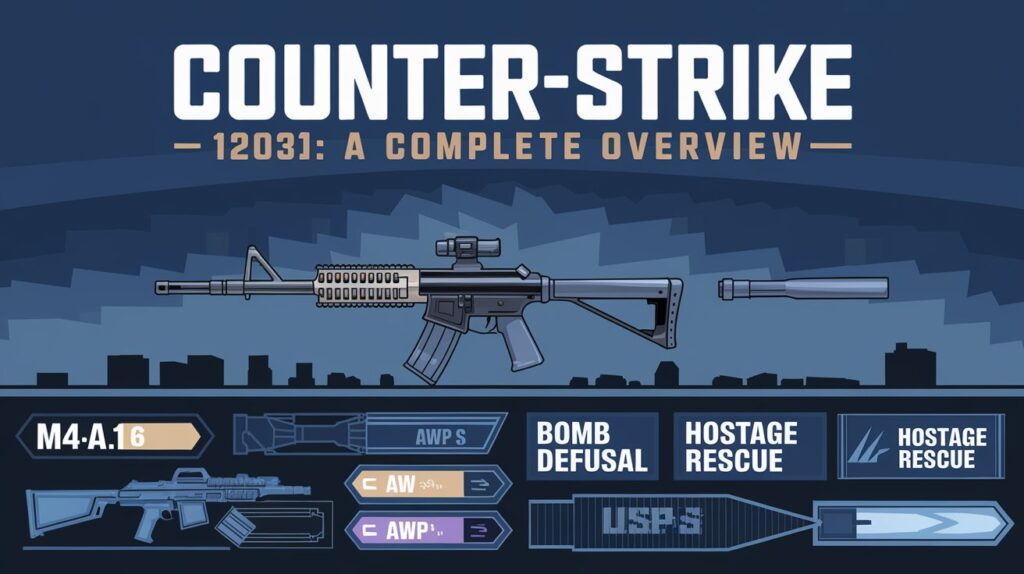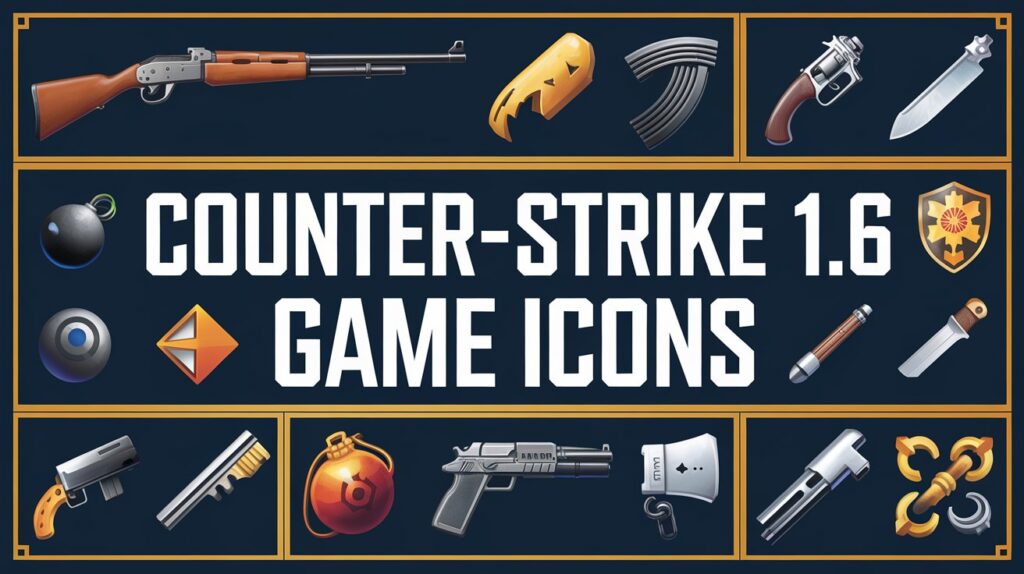Counter-Strike 1.6 (2003) remains one of the most iconic games in the first-person shooter genre. Known for its strategic gameplay, intense battles, and highly competitive community, this version of Counter-Strike (CS) set the standard for multiplayer gaming. But beyond gameplay, the visual elements, particularly game icons and banners, played a significant role in defining the game’s aesthetic appeal. This article will take a close look at these graphical aspects, examining why they mattered, how they evolved, and what made them memorable.
What Are Game Icons and Banners in Counter-Strike 1.6?
Game icons and banners are visual assets that create the first impression of any game. In Counter-Strike 1.6 (2003), these assets had a distinct style, embodying the gritty realism of the game. Icons usually included representations of weapons, characters, and the logo, while banners served as promotional material in-game and online, often featuring character models, action shots, and branding elements.
Icons: Small But Impactful
The icons in Counter-Strike 1.6 were straightforward yet impactful. Whether they represented weapons, teams, or menus, each icon was meticulously designed to fit the game’s theme. Each weapon icon, for instance, highlighted the specific details of that weapon type, from pistols and rifles to grenades, conveying information to players quickly and efficiently. The AK-47 and M4A1 icons became symbols of skill and preference, with each representing a specific playstyle within the game. These icons didn’t just function as visual cues but were emblematic of the player’s commitment to the game’s complex weapon system.
Banners: A Powerful Visual Branding Tool
Banners for Counter-Strike 1.6 (2003) were critical in establishing its presence in gaming communities. Often featured in forums, clan websites, and game servers, banners were designed to capture the intense atmosphere of the game. They included high-quality images of terrorists, counter-terrorists, and famous maps like Dust2 and Aztec. These banners acted as both promotional tools and a point of pride within the community, symbolizing not just a game but an entire culture. Server owners and clan leaders also created custom banners that featured their clan names, providing an extra layer of personalization and pride.

How Did These Icons and Banners Evolve?
Icons and banners in Counter-Strike 1.6 were shaped by the game’s overall aesthetic. The aim was always to keep them minimal yet distinctive, resonating with the serious tone of the game. Over the years, players and artists modified these icons and banners to add a personal touch. Icon packs emerged, designed by fans to give a fresh look to weapon and map icons, while still maintaining the essence of the original game. The availability of these customized packs extended the game’s lifespan, giving players a unique way to connect with the Counter-Strike universe.
Banners saw similar modifications, with fan-made versions incorporating new effects, different color schemes, and popular player quotes or game phrases. Many of these fan-made banners and icons became a form of community artwork, widely shared in forums and websites. This evolution of icons and banners helped Counter-Strike 1.6 stand the test of time, making it feel as vibrant as it was upon its release in 2003.
Why Do Game Icons and Banners Matter?
In Counter-Strike 1.6, game icons and banners were more than just images; they were essential to the immersive experience. They offered immediate information about weapons and maps, reinforcing familiarity. A well-recognized banner could build a connection between players and specific servers, promoting a sense of community and competition.
The icons helped players focus on the game’s essential details without overwhelming them with unnecessary elements, maintaining a balance between simplicity and detail. A glance at an icon could convey crucial information, especially in intense situations where split-second decisions mattered. Banners, meanwhile, were instrumental in community-building, making them indispensable to the Counter-Strike experience.

How Did the Community Shape the Game’s Visual Elements?
The community played a massive role in Counter-Strike 1.6’s (2003) graphic evolution. Fans who were skilled in graphic design crafted their own interpretations of the icons and banners, often uploading them for others to use. Customization became a huge part of the game, as players used icon and banner packs to express their individuality or show affiliation with a clan. This customization aspect didn’t just add to the aesthetic variety but encouraged long-time fans to stay invested in the game, keeping it alive and popular well beyond its initial release.
Several online communities started hosting contests for the best custom banners and icons, which boosted engagement and gave artists a platform to showcase their talent. These community-driven designs reinforced Counter-Strike’s influence on gaming culture, showing how a passionate player base could leave a lasting mark on a game’s identity.
Also Read: Who is Armin Lessani Edmond? An In-Depth Look
Why Is Counter-Strike 1.6 Still Remembered for Its Icons and Banners?
Icons and banners in Counter-Strike 1.6 became iconic in their own right because they weren’t merely visual decorations—they represented skill, strategy, and teamwork. The familiarity with these visuals became part of the player’s experience and contributed to the game’s lasting appeal. As players returned to the game time and again, these images became symbols of nostalgia, reminding them of classic maps, intense moments, and camaraderie with teammates.
For a 2003 game, Counter-Strike 1.6 offered a robust visual language that made it immediately recognizable in the vast FPS landscape. This visual consistency and attention to detail are key reasons the game remains etched in the memory of players worldwide.








[…] Also Read: Counter-Strike 1.6 (2003) Game Icons Banners: A Complete Overview […]